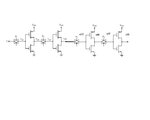andrea22
Junior Member level 2
Does anyone have any tutorial about cmos tg dynamic shift register?
I need an explaination how this circuit works.
What I ment why this circuit only works with non-overlapping clocks,
or why this circuit can't work with overlapping clocks?
I need to prove why this circuit can't work with overlapping clocks.
I need an explaination how this circuit works.
What I ment why this circuit only works with non-overlapping clocks,
or why this circuit can't work with overlapping clocks?
I need to prove why this circuit can't work with overlapping clocks.
